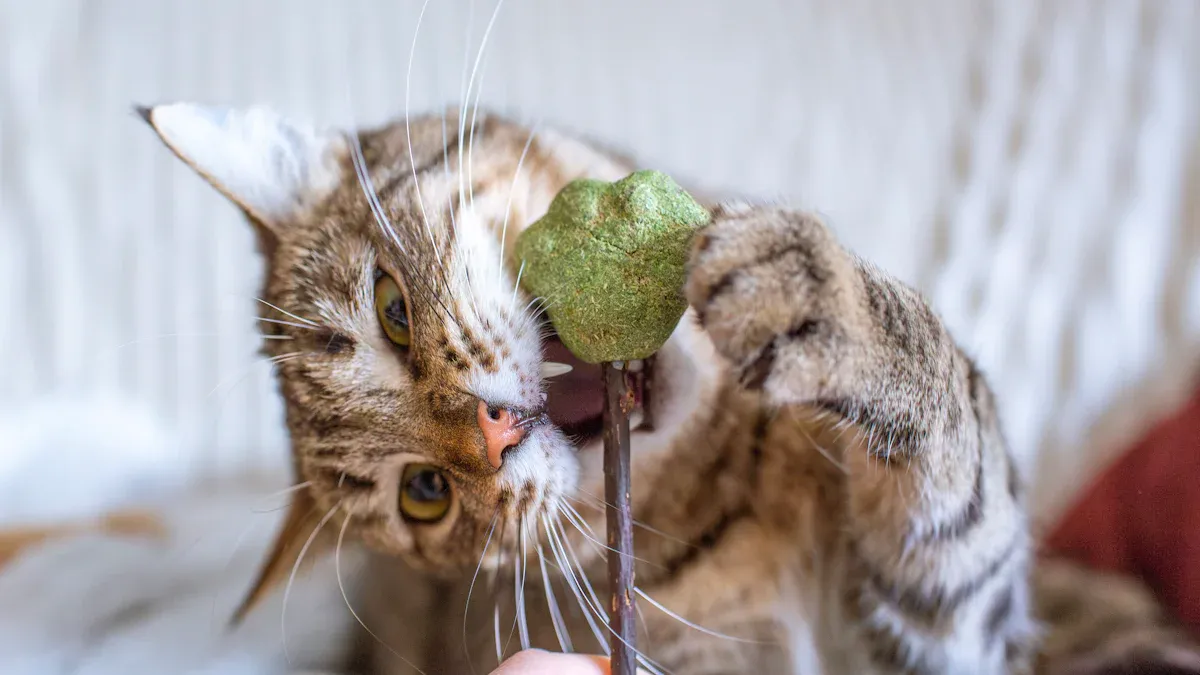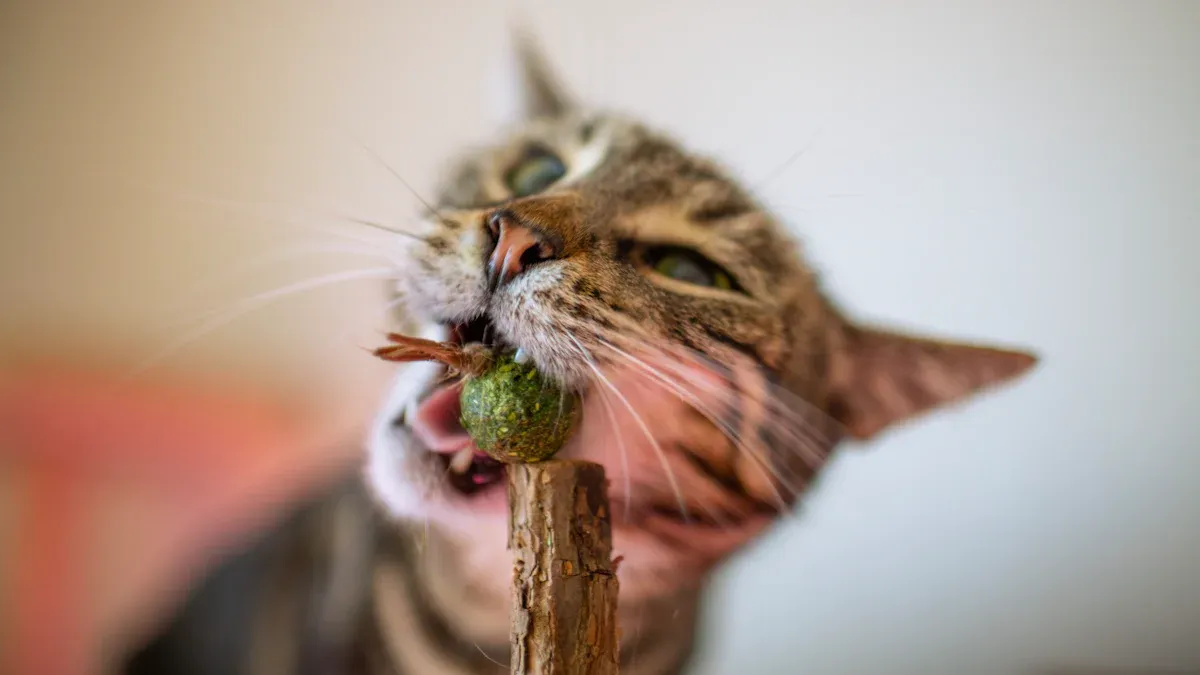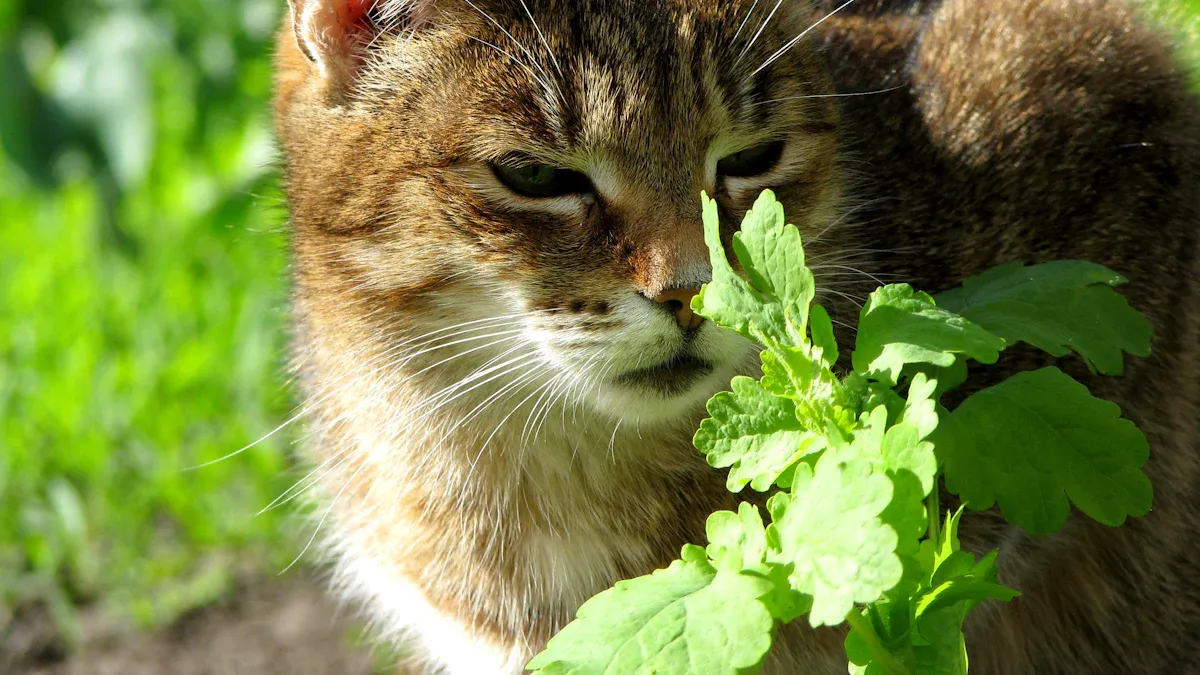Views: 0 Author: Site Editor Publish Time: 2025-07-10 Origin: Site










You should offer your cat a small pinch of catnip—about 1/8 teaspoon to 1 tablespoon—or a catnip-filled toy two to three times per week. Catnip is generally safe and non-addictive, but too much can cause mild digestive upset, such as vomiting or diarrhea. Most cats self-regulate their intake, so overdose is rare. About 67% of domestic cats respond to catnip, while 81.3% of cat owners provide catnip-stuffed toys. Since every cat reacts differently, always monitor your cat’s behavior. A Catnip Ball Toy can make playtime fun and safe for your furry friend.
At Skylark Source, we’ve meticulously crafted our catnip products with this philosophy of safety and moderation in mind. Our catnip is 100% organic and naturally potent, meaning you don’t need a lot to see a big effect. Our catnip-infused toys are designed to release the perfect amount of scent during play, providing a controlled and safe dose of feline fun. We prioritize your cat’s health and happiness above all else, which is why our products are free from fillers, chemicals, and artificial additives. You’re giving your cat a pure, natural experience, and you have the peace of mind that comes from knowing you’re choosing the best.
Give your cat a small pinch of catnip, about 1/8 teaspoon to 1 tablespoon, two to three times per week to keep playtime fun and safe.
Most cats control their own catnip use and stop when they have had enough, but watch for signs like vomiting or diarrhea to avoid giving too much.
Not all cats react to catnip; about two-thirds do, and reactions vary by age, sex, and genetics, so always observe your cat’s behavior.
Avoid giving catnip to kittens under six months, pregnant cats, or cats with seizure disorders, and consult a vet if your cat has health issues.
Using catnip toys like a Catnip Ball Toy can reduce mess, encourage safe play, and keep your cat engaged while making cleanup easier.

Catnip, also known as Nepeta cataria, is a herb from the mint family. You can recognize it by its square stems, grayish leaves with serrated edges, and small white or purple flowers. Catnip grows between 30 and 100 centimeters tall. People have used it for centuries, but it is most famous for its effect on cats.
Catnip contains several natural chemicals, but the most important is nepetalactone. This essential oil gives catnip its unique scent and is responsible for the playful reactions you see in many cats. Other compounds in catnip include monoterpenes, iridoid glucosides, sesquiterpenes, flavonones, and phenols. These chemicals also help catnip repel insects like mosquitoes and flies.
When you give your cat catnip, nepetalactone enters the air and reaches your cat’s nose. The compound binds to special receptors in your cat’s nasal tissue. This action stimulates sensory neurons that send signals to the brain, especially the amygdala and hypothalamus. These brain areas control emotion and pleasure.
As a result, your cat may show a range of behaviors, such as:
Sniffing and licking the catnip
Rubbing or rolling on the floor
Increased playfulness and excitement
The effects usually last 5 to 15 minutes. After that, your cat may lose interest until some time passes.
Not every cat responds to catnip. Genetics play a big role. About 50–70% of cats have the right genes to enjoy catnip. If your cat does not react, it may lack these genes. Some cats that do not respond to catnip may react to other plants like silvervine.
| Behavior/Response Type | Male Cats | Female Cats |
|---|---|---|
| Active catnip response (rolling) | Seen in ~45% adults, less in juveniles | Seen in ~45% adults, less in juveniles |
| Sphinx position (passive) | More frequent in juveniles and adults | Less frequent in juveniles |
| Grooming after catnip | Less likely | More likely |
| Vocalization (miaow) | Less likely | More likely |
| Activity reduction | Less likely | More likely |
You may notice that male and female cats show different behaviors. Females often groom and vocalize more after catnip, while males tend to stay still or take a sphinx-like position. These differences come from brain development, not hormones. Each cat’s reaction is unique, so always observe your pet to see how it responds.
Most cats have a natural ability to control their catnip intake. When you offer catnip, your cat will usually sniff, lick, or roll in it for about 10 to 15 minutes. After this playful burst, your cat enters a "refractory period" that lasts about an hour. During this time, your cat becomes temporarily immune to catnip’s effects and will likely ignore it.
Cats instinctively know when they have had enough catnip and will walk away on their own.
Overexposure can cause mild digestive upset, so moderation is key.
A small amount of catnip is enough to trigger a response. You should observe your cat’s reaction and adjust the amount as needed.
Limiting catnip play sessions to once or twice a week helps prevent your cat from losing interest or developing a mild tolerance.
Tip: If your cat seems uninterested, wait a few days before offering catnip again. This helps keep the experience fresh and exciting.
Scientific studies support the safety of catnip when used as recommended. Research shows that nepetalactone, the active compound, does not cause addiction or psychosis. Catnip serves as a safe form of environmental enrichment for most cats.
Catnip is generally safe, but you should know the possible side effects. Most reactions are mild and short-lived. Here is a summary of what you might see:
| Side Effect Category | Description | Duration / Notes |
|---|---|---|
| Short-term Behavioral Effects | Excitement, rolling, licking, drooling, hyperactivity, rare aggression | 10-15 minutes, followed by 1-2 hour refractory |
| Gastrointestinal Effects | Vomiting, diarrhea if large amounts ingested | Mild, resolves with time |
| Respiratory Effects | Worsening of coughing or wheezing in cats with asthma | Only in cats with pre-existing respiratory issues |
| Long-term Effects | No known adverse effects; non-toxic and non-addictive | No documented long-term side effects |
| Tolerance and Addiction | Mild tolerance possible; no addiction or withdrawal | Tolerance reduces effect if used too often |
Most cats enjoy catnip safely, but you should watch for signs of a negative reaction:
Excessive hyperactivity or uncoordinated movements
Aggression, such as growling or swatting
Vomiting or diarrhea
Overstimulation or abnormal lethargy
These symptoms are rare and usually resolve on their own. If you notice any of these signs, remove the catnip and give your cat a break. Always supervise playtime and use catnip in moderation to keep your cat happy and healthy.
You want to give your cat just enough catnip to spark joy without causing any problems. Most veterinarians agree that a small sprinkle—about 1/8 teaspoon to 1 tablespoon—is plenty for most adult cats. You can place this amount on a scratching post, in a toy, or simply on the floor. Cats usually self-regulate and walk away when they have had enough, so overdose is rare.
Tip: Start with a small pinch the first time you introduce catnip. Watch your cat’s reaction and adjust the amount if needed.
When you introduce catnip for the first time, use a small amount and supervise your cat. Some cats may react right away, while others need a few tries before showing interest. You can try different forms, such as dried leaves, sprays, or catnip-filled toys, to see what your cat enjoys most. Always provide catnip in a calm and safe space, so your cat feels comfortable exploring.
Keep in mind that age matters. Kittens under three months usually do not respond to catnip, and older cats may lose interest over time. Most cats start to enjoy catnip around six months of age. There is no strong evidence that a cat’s size or health status changes the safe amount, but you should always watch for signs of overindulgence, such as vomiting or diarrhea. If your cat eats too much catnip, remove it and give your cat a break.
Here is a quick guide for safe catnip use:
| Cat Age | Recommended Catnip Use | Notes |
|---|---|---|
| Under 3 months | Avoid | Usually no interest or may be repelled |
| 6 months+ | Small pinch (1/8 tsp–1 tbsp) | Most cats respond; supervise use |
| Senior cats | Small pinch | May show less interest |
You should offer catnip as an occasional treat, not a daily routine. Most experts recommend giving catnip to your cat once or twice a week. This schedule helps keep the experience special and prevents your cat from becoming desensitized. If you use catnip too often, your cat may stop responding or lose interest.
Frequent exposure can reduce your cat’s sensitivity to catnip.
Limit catnip play sessions to every few days for best results.
If your cat’s reaction fades, take a longer break before offering catnip again.
The effects of catnip last about 10 to 15 minutes. Afterward, your cat enters a “refractory period” and will not respond to catnip for at least 30 minutes to two hours. By spacing out catnip sessions, you help your cat stay excited and engaged each time.
Note: Every cat is different. Some cats may enjoy catnip more often, while others need longer breaks. Always observe your cat’s behavior and adjust the frequency to match their needs.
When you introduce catnip, start slow. Offer it once a week and see how your cat reacts. If your cat enjoys it and shows no negative effects, you can try twice a week. Remember, moderation keeps catnip fun and safe for your furry friend.

A Catnip Ball Toy can transform your cat’s playtime into a safe and stimulating experience. You should choose a toy made from soft, pet-safe materials. SKYLARK’s Catnip Ball Toy uses natural plant mint, which attracts most cats and encourages interactive play. The rolling motion of the ball taps into your cat’s natural hunting instincts, making play more engaging.
You can follow these tips to get the most out of each play session:
Always supervise your cat during play. Watch for signs of overstimulation, such as aggressive behavior or excessive excitement.
Limit each play session to 10–15 minutes. This keeps your cat interested and prevents boredom.
Offer the Catnip Ball Toy two to three times per week. This schedule helps maintain your cat’s sensitivity to catnip and keeps playtime special.
Remove the toy after play. This prevents your cat from becoming desensitized to the catnip’s effects.
Inspect the toy before each session. Make sure there are no loose parts or damage that could pose a choking hazard.
Tip: The compressed catnip inside the ball reduces mess compared to loose catnip. It also keeps the scent fresh for longer, so your cat stays interested.
A Catnip Ball Toy offers several advantages over loose catnip:
It creates less mess because the catnip stays inside the ball.
The toy lasts longer and provides extended enrichment.
The rolling action stimulates your cat’s prey drive.
Airtight packaging preserves the aroma, keeping your cat engaged.
The toy safely redirects chewing and biting to an appropriate object.
You can tailor play sessions to your cat’s preferences. Some cats enjoy shorter bursts of play, while others like to chase and bat the ball for the full 15 minutes. Always observe your cat and adjust the routine as needed.
Regular maintenance of your Catnip Ball Toy ensures both safety and enjoyment. You should check the toy for wear and tear after each play session. If you notice frayed fabric, broken seams, or a misshapen ball, replace the toy right away. Damaged toys can pose a choking risk or cause injury.
To keep the toy fresh and hygienic, follow these steps:
Clean the Catnip Ball Toy regularly. Wipe it with a damp cloth or use a mild soap solution, then rinse and air dry.
If the toy has removable parts, wash them separately according to the manufacturer’s instructions.
Refresh or replace the catnip inside the toy about once a week, or at least every 10 days. This keeps the scent strong and appealing.
Store extra catnip in a cool, dark place to preserve its potency.
Always supervise your cat during play to ensure the toy remains safe.
| Maintenance Task | Frequency | Why It Matters |
|---|---|---|
| Inspect for damage | After each use | Prevents choking or injury |
| Clean the toy | Weekly | Maintains hygiene |
| Refresh catnip | Weekly/10 days | Keeps scent strong and engaging |
| Replace if damaged | Immediately | Ensures ongoing safety |
SKYLARK’s Catnip Ball Toy uses soft materials and natural catnip, making it a safe and effective choice for your cat. By following these tips, you can provide your cat with a fun, enriching, and safe play experience every week.
Most kittens under six months old do not respond to catnip. Their sense of smell is still developing, and they lack the necessary receptors for nepetalactone, the active compound in catnip. Studies show that about 90% of kittens younger than six months show no reaction at all. You should wait until your kitten is at least six months old before introducing catnip. Introducing catnip too early will likely have no effect and may even cause confusion or overstimulation.
Tip: Start with a small amount when your kitten reaches six months. Watch for any signs of excessive drooling, vomiting, or overstimulation.
Here are some key points to remember:
Kittens under six months usually do not respond to catnip.
Wait until your kitten is at least six months old before offering catnip.
Always introduce catnip gradually and avoid daily use.
Some cats may react to catnip with mild aggression, such as growling or swatting. If you have more than one cat, giving catnip to all of them at once can sometimes lead to fights. You should offer catnip to one cat at a time, especially in multi-cat homes. If your cat has a history of behavioral problems or anxiety, catnip may worsen these issues. In these cases, consult your veterinarian before introducing catnip.
Give catnip to one cat at a time to prevent fights.
Monitor your cat for signs of aggression or overstimulation.
Catnip can help redirect scratching or encourage use of new beds, but always supervise play.
Catnip can also help calm some cats before stressful events, but moderation is important to avoid overstimulation.
Catnip is safe for most healthy adult cats. However, if your cat has a history of seizures or epilepsy, you should avoid catnip. While no direct link exists between catnip and seizures in cats, related plants have caused seizures in other animals. Catnip acts as a uterine stimulant, so you should not give it to pregnant cats. Cats with heart disease, diabetes, or hypertension can usually enjoy catnip safely, but always use caution and watch for any unusual reactions.
| Health Condition | Catnip Use Recommendation |
|---|---|
| Seizure disorders | Avoid catnip |
| Pregnancy | Avoid catnip |
| Heart disease | Generally safe, monitor closely |
| Hypertension/Diabetes | Generally safe, monitor closely |
If you have any concerns about your cat’s health, talk to your veterinarian before offering catnip. Always monitor your cat for any adverse reactions.
You should give your cat small amounts of catnip only a few times per week. Always watch your cat during and after play to spot signs of enjoyment or any problems. Most cats respond well, but some may not react at all. Catnip Ball Toy options, like those from SKYLARK, offer a safe and fun way to enrich your cat’s environment. If you feel unsure about your cat’s response, talk to your veterinarian for advice.
You can watch your cat’s behavior after you offer catnip. Signs include rolling, rubbing, sniffing, or playful activity. Some cats may ignore it. If your cat shows no interest, it may not have the gene that responds to catnip.
You should not give catnip daily. Frequent use can make your cat less sensitive. Offer catnip two to three times per week. This schedule keeps playtime exciting and safe.
Catnip is safe for most senior cats. Some older cats may not react as strongly. Always start with a small amount and watch for any unusual behavior. If your cat has health issues, ask your veterinarian before use.
If your cat eats too much catnip, you may see mild vomiting or diarrhea. Remove the catnip and give your cat water. Most cats recover quickly. If symptoms last more than a day, contact your veterinarian.